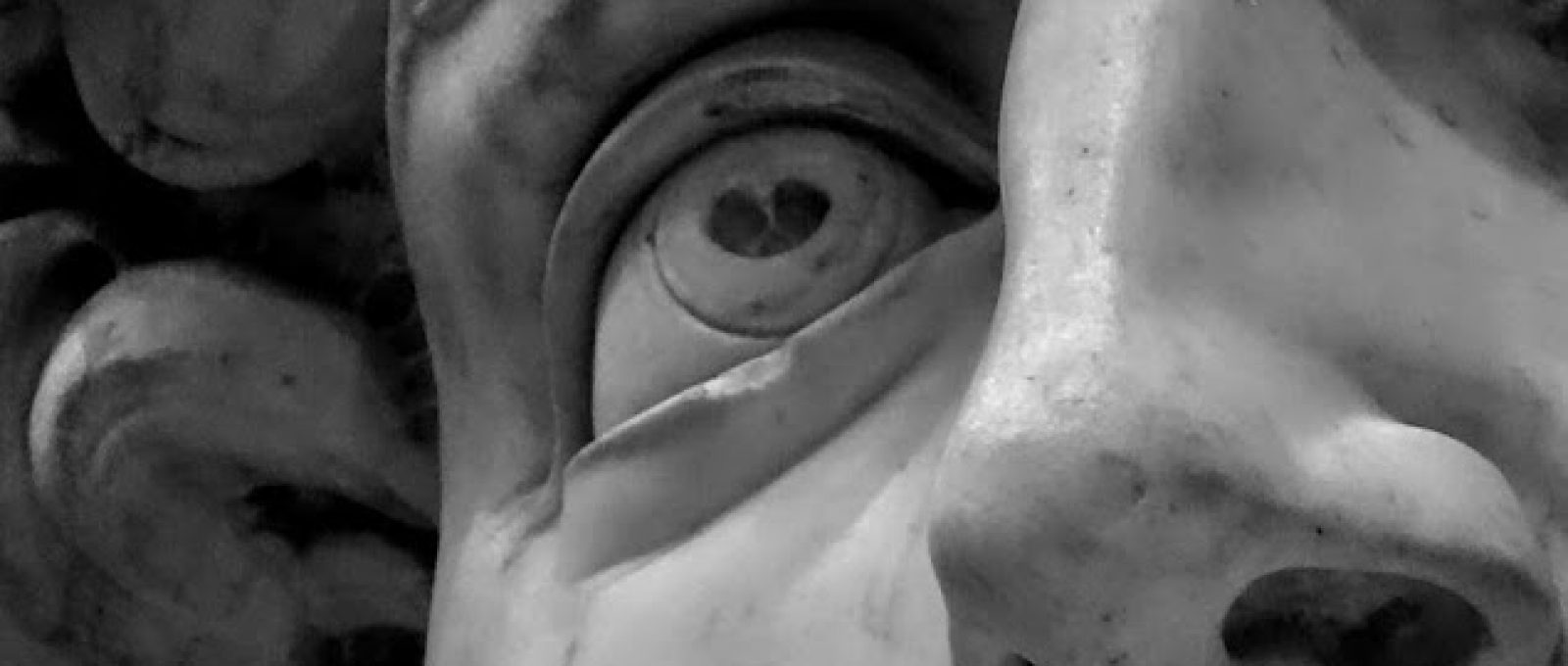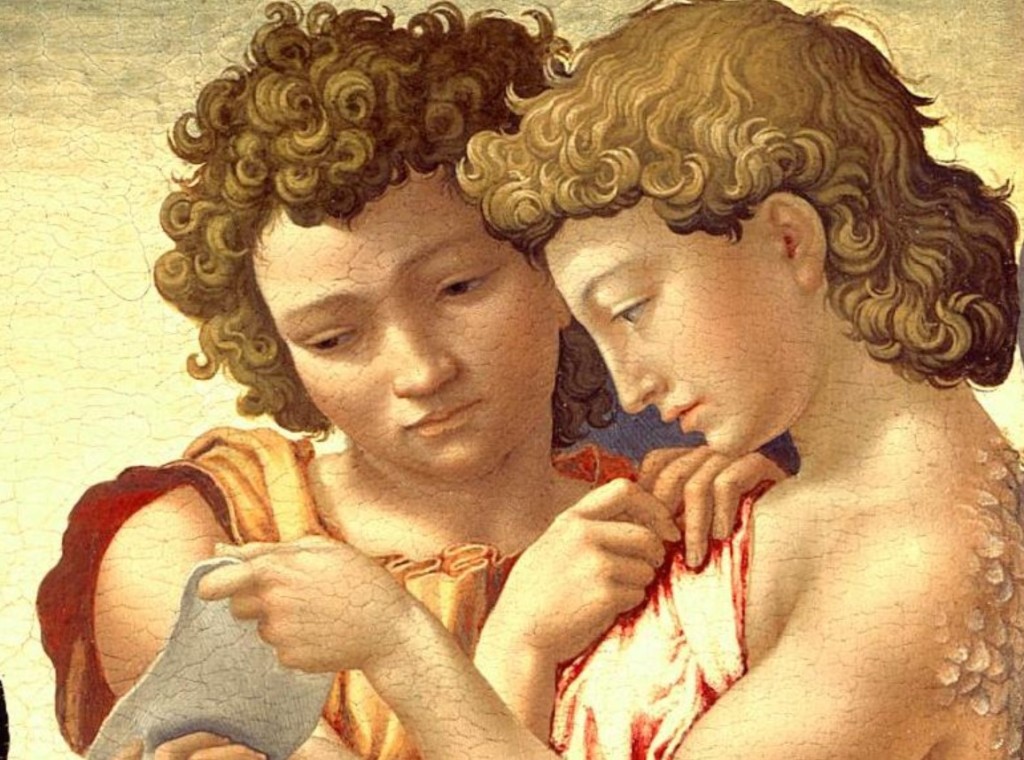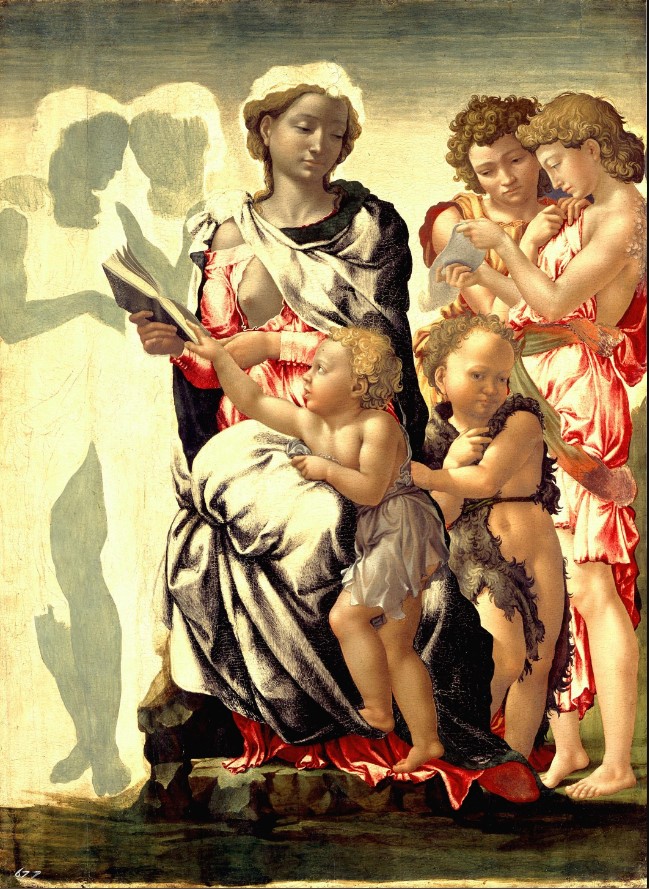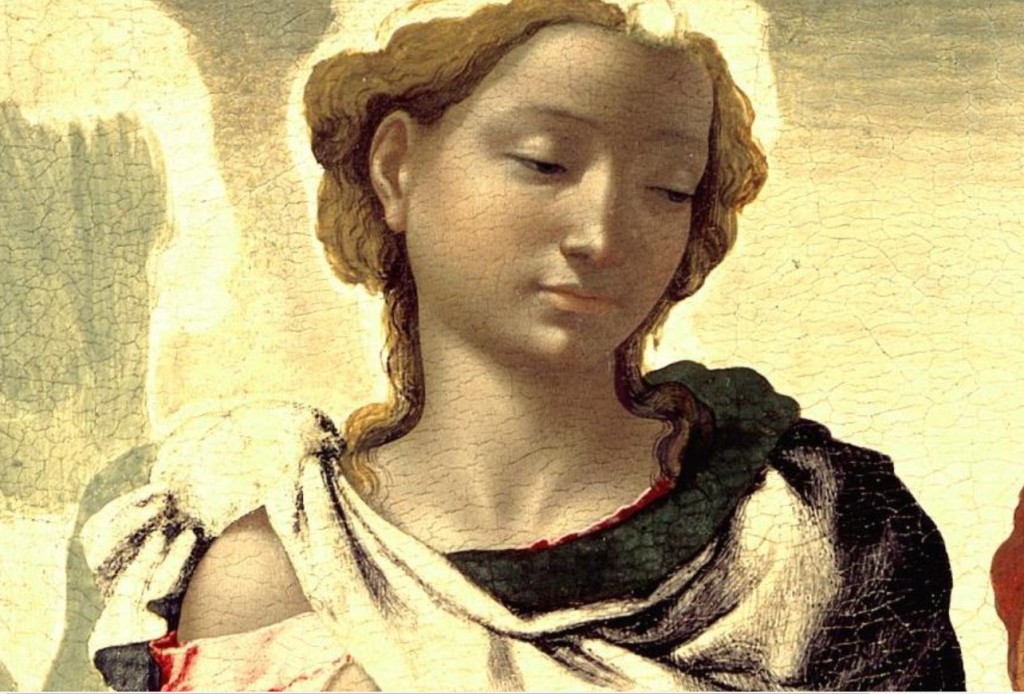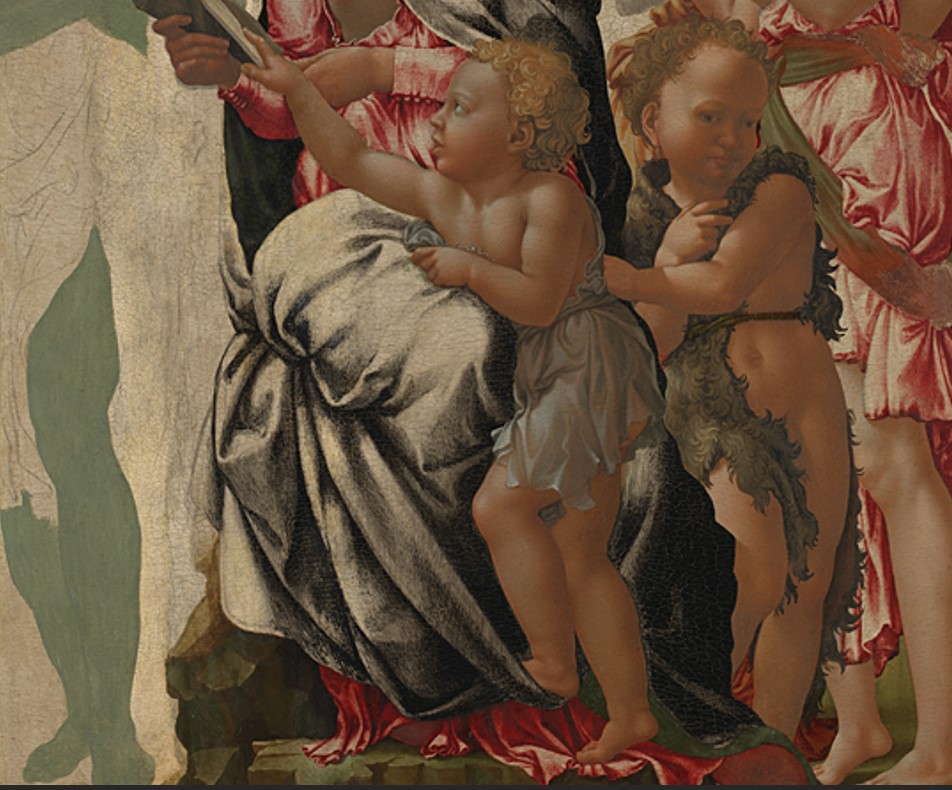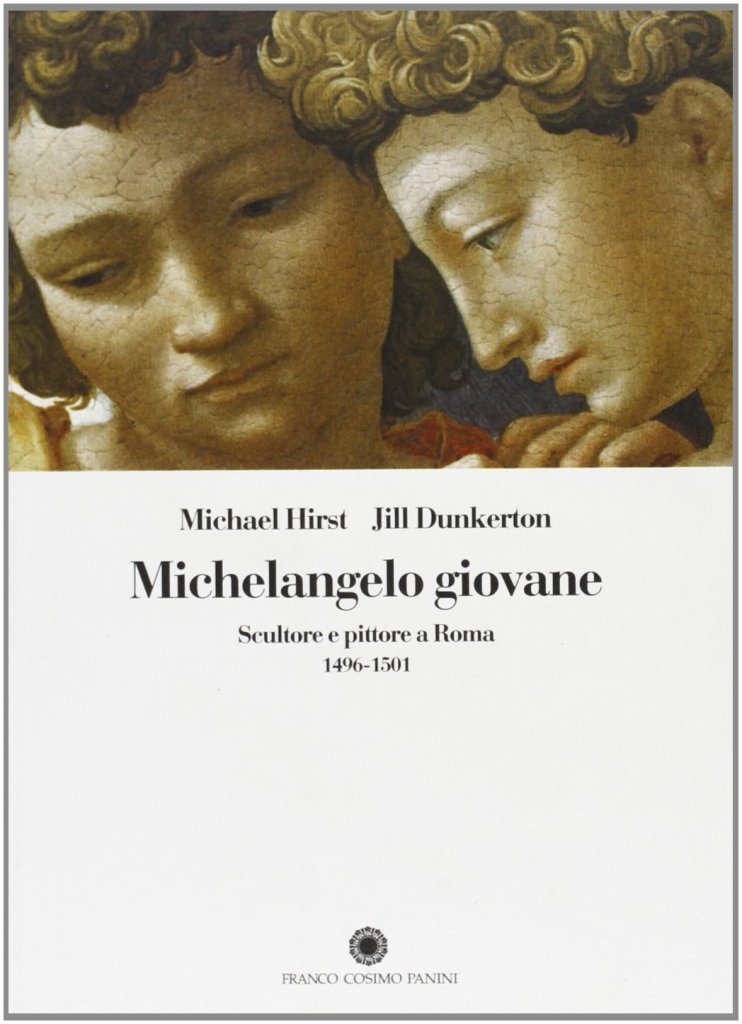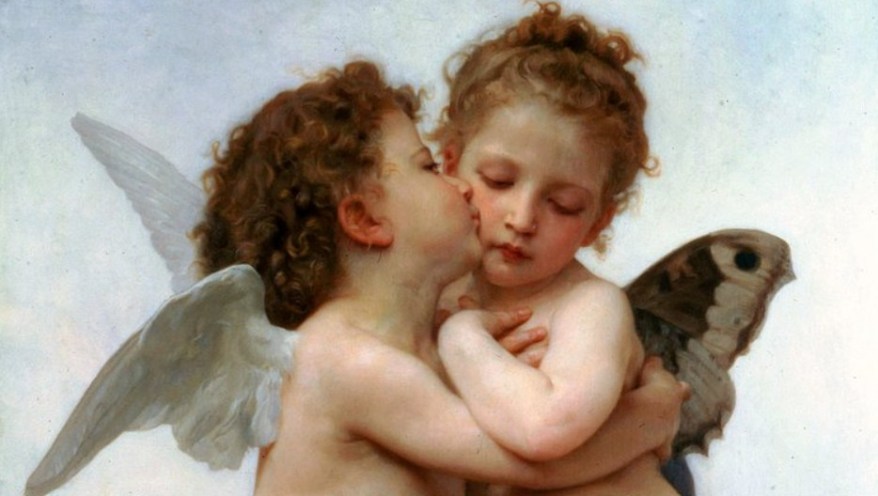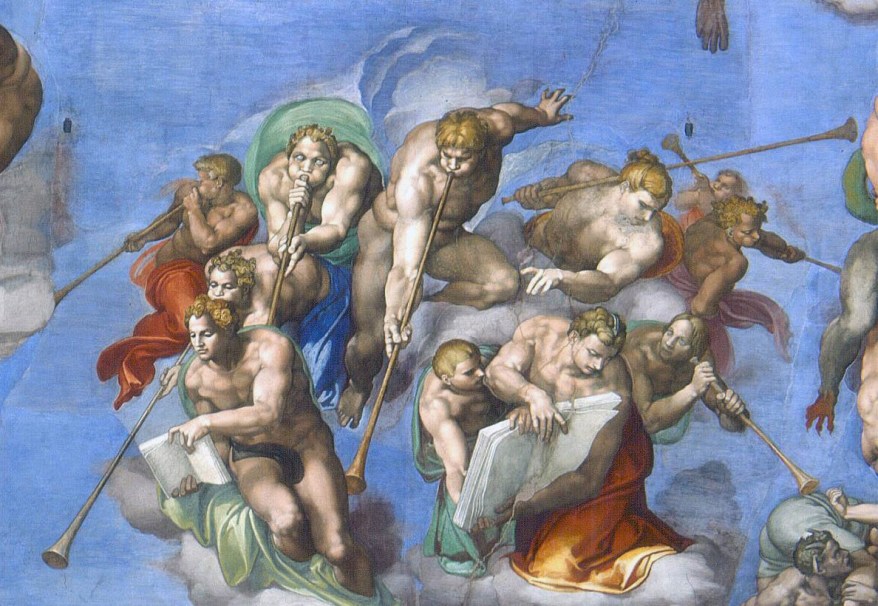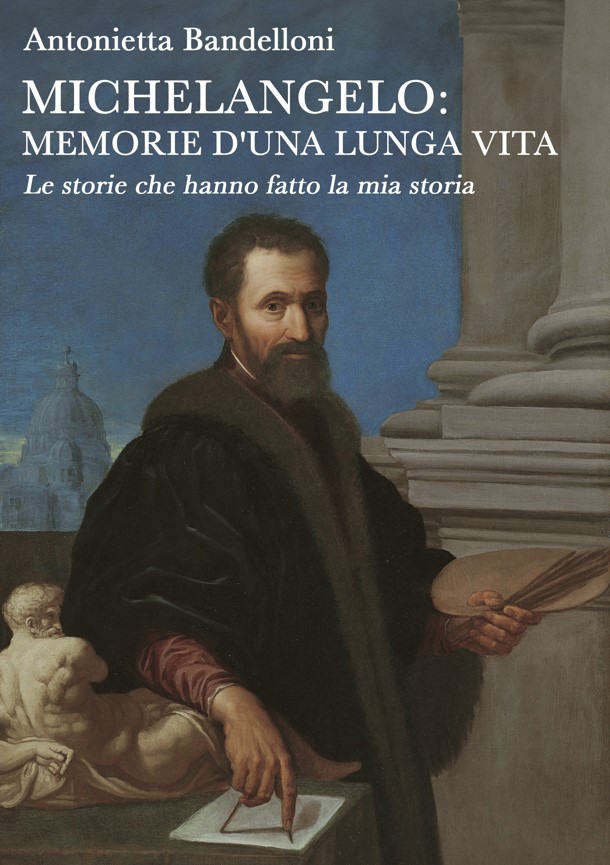Quel prelievo bancario fatto per dipingere un quadro di legno
Appena finito di scolpire il Bacco, a Roma, mi volli mettere a dipingere. Per comprare ciò che mi occorreva per farlo, prelevai dal mio conto una somma di denaro destinata proprio “Per un cuadro di legno per dipingerlo”.
Era il 1497. Di questa tavola che realizzai non ci sono altre notizie più dettagliate e si presume possa essere il dipinto della Madonna con Bambino, San Giovannino e Angeli, più nota come Madonna di Manchester, oggi appartenente alla National Gallery di Londra.
Non è possibile risalire né a un eventuale committente nè la destinazione originaria dell’opera. Nel caso in cui fosse di mano mia, la Madonna di Manchester sarebbe il dipinto più antico di mia mano sopravvissuto fino ai vostro giorni.
Come potete vedere dalle immagini, è un’opera non portata a termine. Il mantello nero della Vergine era stato preparato per ricevere il colore blu e gli angeli che si trovano sulla sinistra sono stati appena tracciati.
La Madonna siede al di sopra di una roccia accanto a San Giovannino, patrono di Firenze e Cristo bambino. Ai lati del gruppo centrale ci sono due angeli a destra e due a sinistra. San Giovanni Battista abbigliato con la pelle di cammello guarda lo spettatore preannunciando con quello sguardo stranito la Passione di Cristo.
Osservando bene la tavola si nota che la Madonna ha un seno scoperto e lascia intendere che ha appena terminato di allattare il Figlio.
La tavola è formata da tre pannelli di legno e in origine era rinforzata sul retro con delle traverse che nel tempo sono andate perdute. È stata dipinta con pigmenti legati a uovo e la base è stata colorita con della terra verde. La stessa terra verde che i Ghirlandaio usavano per far da base alle loro opere. Questo colore da ottimi risultati quando poi si vanno a stendere le velature successive per creare gli incarnati delle figure.
Sappiamo per certo che quest’opera si trovava a Villa Borghese nel 1700 e la sua notorietà esplose grazie alla mostra Art Treasures del 1857, organizzata a Manchester. Fu proprio in quell’occasione che la tavola acquisì il nome con il quale oggi la conosciamo.
Mentre Federico Zeri nel 1953 sosteneva la Madonna di Manchester appartenesse a un gruppo formato da sette dipinti da attribuire a non non identificato Maestro di Manchester, in una mostra successiva del 1994 vennero proposti studi fatti a seguire, portando a pensare il gruppo di tavole fosse realizzato da pittori di secondo piano collegati in qualche modo a me come per esempio Piero d’Argenta e l’Indaco.
Il non finito dell’opera non aiuta a risolvere certe problematiche relative all’attribuzione.
Per il momento il vostro Michelangelo Buonarroti vi saluta dandovi appuntamento ai prossimi post e sui social.

Sostienici – Support Us
Se questo blog ti piace e ti appassiona, puoi aiutarci a farlo crescere sempre più sostenendoci in modo concreto condividendo i post, seguendo le pagine social e con un contributo che ci aiuta ad andare avanti con il nostro lavoro di divulgazione. . ENGLISH: If you like and are passionate about this blog, you can help us make it grow more and more by supporting us in a concrete way by sharing posts, following social pages and with a contribution that helps us to move forward with our dissemination work.
8,00 €
That bank withdrawal made to paint a wooden picture
As soon as I finished sculpting the Bacchus, in Rome, I started painting and to buy what I needed to do it, I withdrew a sum of money from my account intended precisely “For a wooden square to paint it”.
It was 1497. There is no other more detailed information about this panel that I made and it is presumed that it could be the painting of the Madonna with Child, Saint John and Angels, better known as the Manchester Madonna, now belonging to the National Gallery in London.
It is not possible to trace either a possible client or the original destination of the work. If it were by my hand, it would be Our Lady of Manchester and it would be the oldest painting by my hand that has survived to this day. As you can see from the images, it is an unfinished work. The black cloak of the Virgin had been prepared to receive the blue color and the angels on the left have just been traced.
The Madonna sits on top of a rock next to San Giovannino, patron saint of Florence, and Christ children. On the sides of the central group there are two angels on the right and two on the left. Saint John the Baptist dressed in camel skin looks at the viewer, announcing the Passion of Christ with that dazed look.
Looking closely at the table you notice that the Madonna has one breast exposed and she suggests that she has just finished breastfeeding her son.
The table is made up of three wooden panels and was originally reinforced on the back with crosspieces which have been lost over time. It was painted with egg-bound pigments and the base was colored with green earth. The same green earth that the Ghirlandaios used to base their works. This color gives excellent results when the subsequent glazes are applied to create the flesh tones of the figures.
We know for sure that this work was in Villa Borghese in 1700 and its notoriety exploded thanks to the Art Treasures exhibition of 1857, organized in Manchester. It was precisely on that occasion that the table acquired the name by which we know it today.
While Federico Zeri in 1953 maintained that the Madonna of Manchester belonged to a group made up of seven paintings to be attributed to an unidentified Master of Manchester, in a subsequent exhibition in 1994 subsequent studies were proposed, leading one to think the group of panels was created by second rate painters connected in some way to me such as Piero d’Argenta and Indigo.
The unfinished nature of the work does not help resolve certain problems relating to attribution.
For the moment, your Michelangelo Buonarroti greets you and will meet you in future posts and on social media.

Sostienici – Support Us
Se questo blog ti piace e ti appassiona, puoi aiutarci a farlo crescere sempre più sostenendoci in modo concreto condividendo i post, seguendo le pagine social e con un contributo che ci aiuta ad andare avanti con il nostro lavoro di divulgazione. . ENGLISH: If you like and are passionate about this blog, you can help us make it grow more and more by supporting us in a concrete way by sharing posts, following social pages and with a contribution that helps us to move forward with our dissemination work.
8,00 €
-
11 gennaio 1494: muore Domenico Ghirlandaio, l’artista che mi insegnò a dipingere
🇮🇹11 gennaio 1494 muore a Firenze Domenico Ghirlandaio, il pittore che ha raccontato il volto del Rinascimento e che ebbe me a bottega già da quando avevo 12 anni… 🇬🇧January 11, 1494, Domenico Ghirlandaio, the painter who depicted the face of the Renaissance and who had me in his workshop since I was 12, died…
-
Amore e Psiche bambini di Bouguereau: un capolavoro del Neoclassicismo tardo
🇮🇹Amore e Psiche bambini è uno dei dipinti più delicati e poetici di William-Adolphe Bouguereau, realizzato nel 1890… 🇬🇧Cupid and Psyche as Children is one of William-Adolphe Bouguereau’s most delicate and poetic paintings, created in 1890…
-
Quando i libri diventano simboli: cosa raccontano davvero nei capolavori della pittura
🇮🇹I libri nelle opere d’arte non sono mai solo dettagli fine a sé stessi. Spesso custodiscono significati nascosti, simboli di conoscenza, fede o identità. Dal Medioevo al Rinascimento, leggere nei quadri era un gesto potente e poteva avere vari significati… 🇬🇧Books in artworks are never just details for their own sake. They often hold hidden…

